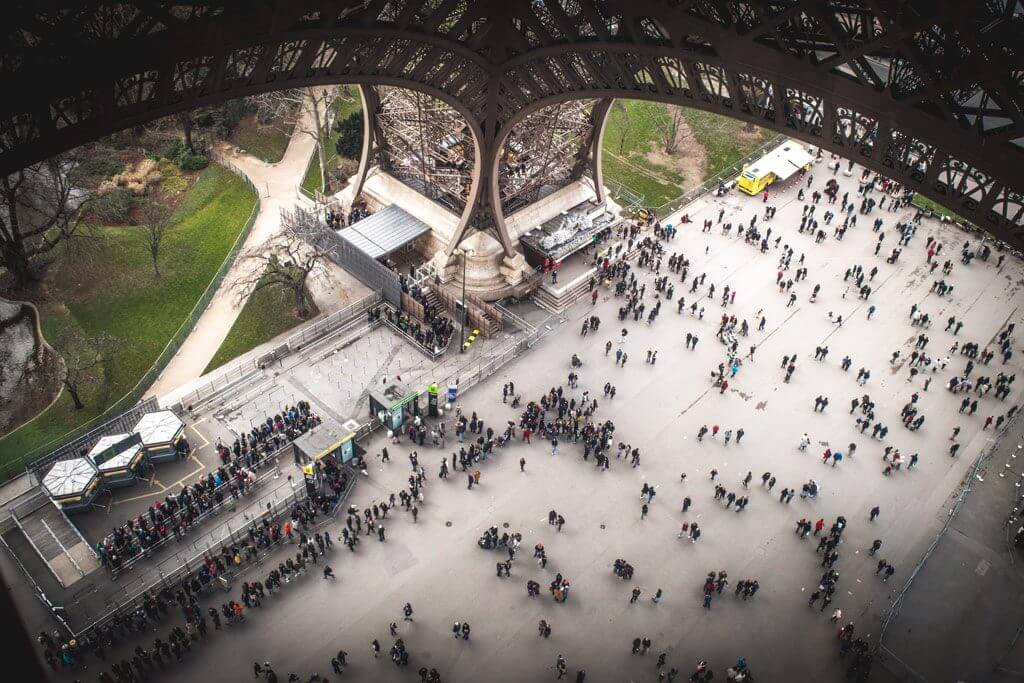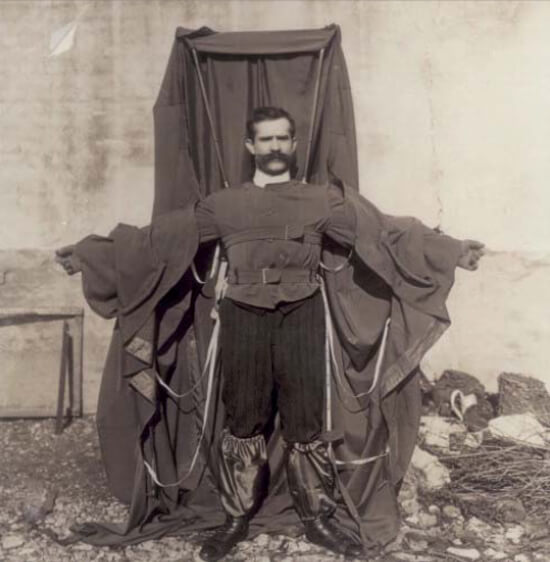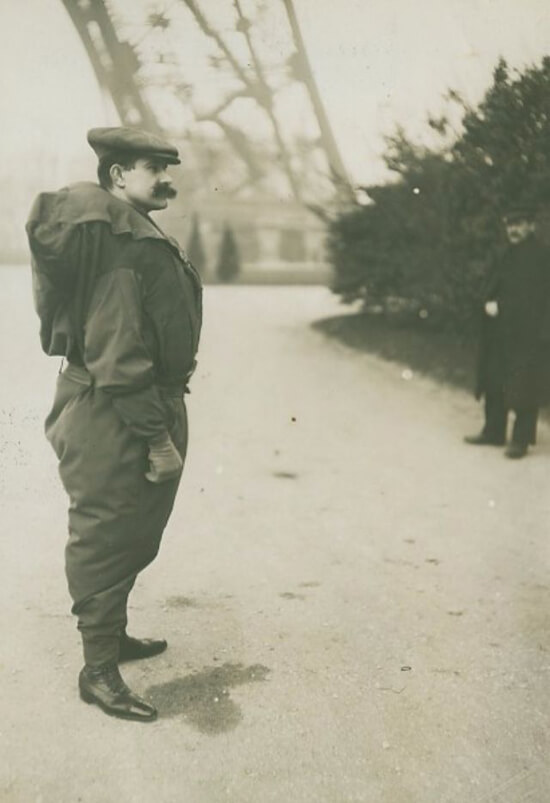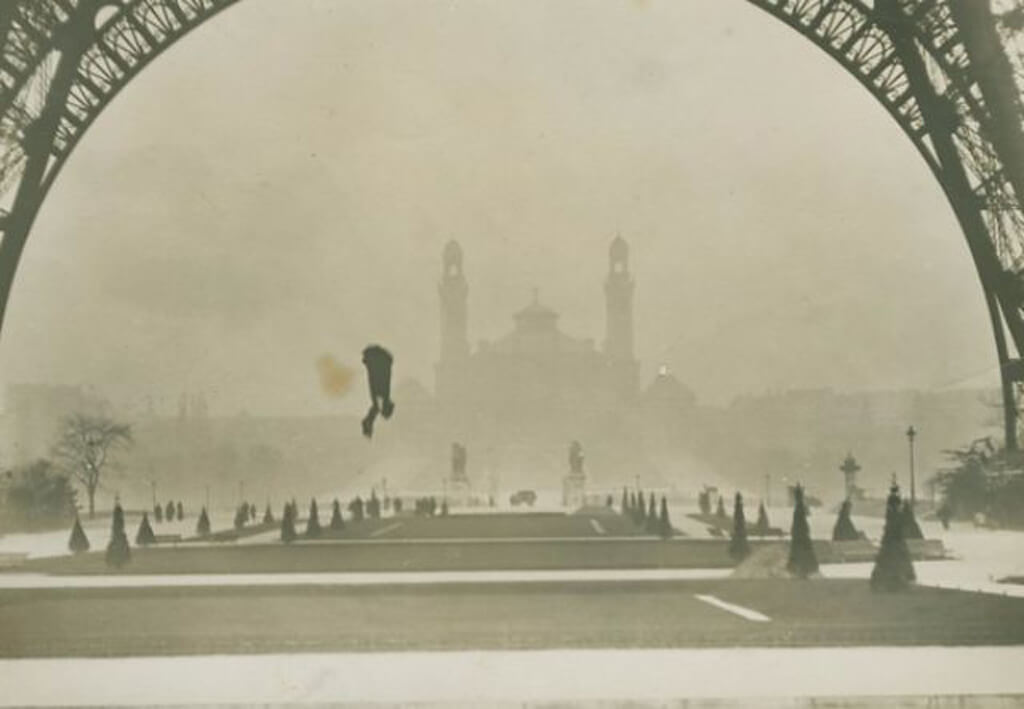The Eiffel Tower is one of the top landmarks in Paris, the symbol of Paris and France. Because of its size, there are many lovely Eiffel Tower views from different angles in the city, and it is also a unique place to visit, with many fascinating stories around it. Keep reading for one of the most incredible Eiffel Tower stories, the first base jump from the Eiffel Tower.

TIP: Is it worth climbing up the Eiffel Tower (for sightseeing)? Check it out in this post
The Story of François Reichelt, “The Flying Taylor”

François (Franz) Reichelt (1879-1912) was a tailor for ladies at 8 rue Gaillon in Paris and an aviation passionate. At a time when fatal accidents were frequent in aviation, Franz decided he would become famous by inventing the first parachute coat for pilots, a parachute that would allow pilots to survive shortfalls.
His brand new handmade khaki jumpsuit in rubberized canvas featured a design inspired by the wings of bats. With a surface of 12 m2 and a diameter of 6.5 m (refined version), the batman-coat weighed 9 kg!
The invention looked brilliant: during the fall, this oversized coat with a kind of chimney had to open under the effect of the wind and slow down the descent.
Of course, when people invent new things, it is good practice to test them! And that’s what Reichelt did from his home at rue Gaillon: he put the parachute coat on the back of several mannequins and hop! he pushed them from his window, several floors high.
All of These Jump-tests Ended in Failure. ALL of Them.
Despite his enthusiasm, Reichelt’s early prototypes largely failed, and his dummies dropped like a stone to the ground. On one occasion, Reichelt even tested out one of his parachutes himself and broke his leg.
But Reichelt was convinced that he could get his invention to work! In those failed tests from home, the suit did not have time to make contact with the air, but the results would be wonderful if he had fifty or one hundred meters instead of twenty-five.
Reichelt concluded that he just needed the right height from which to jump to succeed. He soon became convinced he should try the leap from the Eiffel Tower, the tallest building in Paris at the time, from which his parachute suit could deliver him safely to the ground.
Determined, Franz Reichelt began lobbying the Parisian police to let him test his invention from the Eiffel Tower. He never said he would be testing himself, so after a year of lobbying, the police finally agreed.
Ride or Die: A Man Jumps Off the Eiffel Tower

4th February 1912 8 am. Our superhero climbed up to the first floor of the Eiffel Tower for his big day. The news of the first BASE jump in history (although that name had not been invented yet) generated great expectations, and the audience on the floor was numerous.
But to the abject horror of his friends (and the police of Paris), he hadn’t brought any dummies with him, and he was wearing the Eiffel Tower wingsuit himself.
“Among the spectators… only he seemed happy,” the French paper Le Matin wrote the following day. “Everyone thought he would kill himself.” Reichelt’s friends and the security guard in the Eiffel Tower tried to convince him not to jump, saying it was too cold and windy, but Reichelt was determined: “I intend to prove the worth of my invention,” he announced.
From the railing, Franz glanced down. He paused there for about forty seconds as if he was gathering his courage. He hesitated and began to tremble. He hesitated again, and then he threw himself into the air (warning: this video does not have a happy end):
- 57 m height (from the Eiffel Tower’s first floor to the ground)
- 4 seconds of free fall
- A 20 cm x 30 cm crater on the ground
- Big drama.
What Happened?

The entire jump was filmed, as there were two camera crews at the scene (one with Reichelt at the jump spot and another at the bottom). According to the records, the clothing unfolded, but because of the air currents that rush under the Eiffel Tower, the canvas folded and wrapped around Reichelt’s body.
Sadly, Reichelt is not remembered as an aviation pioneer but as another example of human stupidity. In a cruel twist, only two days earlier, an American Jockey, Frederick R. Law, had successfully parachuted from the torch of the Statue of Liberty over 63m using the now widely recognized half-sphere design.

